Castles of "Croatia" KNIN FORTRESS vs KOŽLJAK

KNIN FORTRESS
Knin Fortress (Croatian: Kninska tvrđava) is located near the tallest mountain in Croatia (Dinara) and near the source of the river Krka. It is the second largest fortress in Croatia and most significant defensive stronghold, and a historical town in the Šibenik-Knin County in the Dalmatian hinterland. The construction of the fortress started as early as 9th century, while the current state was brought up in 17th and 18th centuries. It reached its peak during the reign of Demetrius Zvonimir, King of Croatia from 1076, as it served as a political center of the Croatian Kingdom under him. It is situated on the main transport corridor leading from Dalmatia to continental Croatia and Bosnia. The Knin Fortress lies on top of the steep Spas mountain, just 100 meters (328 ft) above the Croatian town of Knin, whose historical location was formed quite early at the foothills of the same mountain. Archaeological excavations date that this area was populated since the 6th century. It is 470 metres (1,540 ft) long, and 110 meters (361 ft) wide, elevated at 345 metres (1,132 ft) above the sea. The original look of the building, because of the lack of its material, isn't completely known. According to other similar fortifications from that time, it is assumed that it was surrounded by high walls, while the construction was accommodated to the terrain; it is environmentally secured by steep slopes on some places. The fortress comprises three parts: northern, middle and southern. Each part of the fortress is protected by loopholes and gun holes, and is connected to other parts by the city gates and drawbridges. The formation of the northern section, according to recent research, happened from the middle of the 8th century to the end of the 11th century. Baroque stone gates are set on the main entrance to the fortress, where the doors are made out of oakwood and strengthened with iron nails. This monumental entrance was most likely constructed by Ignacije Macanović, a builder from Trogir. Above the doors, the symbol of the Venetian Republic can be seen. Towards the northern part, on the left side, a building of the governor of arms used to be there; today it is the old city hall. Left of it were the barracks which eventually became the gallery of the museum of Knin. On the same location a memorial was elevated to fra Lujo Marun (1857–1939), a friar who was the first to instigate archaeological excavations in this area, and to discover many remains of the old Croatian culture. Within the church of St. Barbara, a bell is kept as a gift from Pope John Paul II, which was given to Knin during his stay in 1994. The current state was undertaken by a Venetian military engineer, Alberghetti, where an inscription suggests that the construction works were completed in 1711. It is protected as a historical urban complex and is inscribed in the register of the Cultural heritage of Croatia as a monument of top importance. The church of St. Barbara, dedicated to Cyril and Methodius, also holds an epitaph written in Old Church Slavonic:
Statistics for this Xoptio

KOŽLJAK
Kožljak (Kozljak, Italian: Cosliacco, German: Waxenstein) is a village in Istria County, Croatia, in the municipality of Kršan. In 2011, the population of the village is 160. The settlement besides of the village consists of nearby homonymous medieval ruinous castle. It is located in the Eastern part of Istria, on the western slopes of mountain Učka along the Čepić field, on the local road Šušnjevica-Vozlići (L50180), 6 km east from the municipal center Kršan (D64), and 13 km north-east of the city of Labin. In the village is the railway station of Lupoglav-Štalije route. Nearby is abandoned village Zagrad which leads to the castle. The Croatian primary school was founded in 1907. The inhabitants mainly lived from agriculture, and until the drain of former Lake Čepić, even from fishery. Vladimir Nazor inspired by castles story wrote ballad Krvava košulja and novel Krvavi dani. In the vicinity of the village is the medieval ruinous castle. The castle is located on a steep cliff (184 m.a.s.l.), along the old road which connected Istria with Croatian Littoral (Kvarner). It was built on the place of prehistoric hill fort. It was first mentioned at the time of Patriarchate of Aquileia in 1102 under name Castrum Iosilach in the grant by Ulric II and his wife Adelaide to Aquileia patriarchs. Later it is also mentioned as Gosilach, Wachsenstein or Waxenstein (from 13th century), Cosgliacco (1275), and Kožlak (Istrian Demarcation, 13th-14th century). It belonged to the Patria del Friuli, and from 13th century as loaned feud of County of Gorizia, what would become Austrian part of Istria (March of Istria), situated at the very border area between Austrian and Venetian Istria. From the 13th century, the feud was hereditary possession of Counts of Görz. Its first manor was counts vassal and castle governor Philip, mentioned several times between 1234 and 1264, and then his heirs, son Karstman I, grandson Karstman II, and great grandson Filip Macić (was involved with Istrian Demarcation) and Ulrich. With the death of count Heinrich III in 1323, the castle was in conflict of interest between Gorizia counts, Aquileia patriarchs and Venice. The counts of Gorizia, Heinrich III's wife Beatrix and brother Albert II, ascribed the feud and in 1325 give away for debt settlement to Hugo III of Duino, but patriarch Pagano della Torre prevented it in 1328. In 1331-1332, helped by Fridrik III of Krk (Frankopan), the Venice tried to take possession of the castle, but unsuccessfully besieged it almost a year. In 1342, although patriarch Bertram of St. Genesius gave the feud to Juraj and Rudolf III of Duin and their cousin Hugo V, it also ascribed by count Albert III, who somehow managed to acquire it and defend it between 1359 and 1361 from patriarch Lodovico della Torre. In 1508, the Venice, and in the 15th century on two occasions Ivan VII Frankopan of Krk, tried to conquer it.